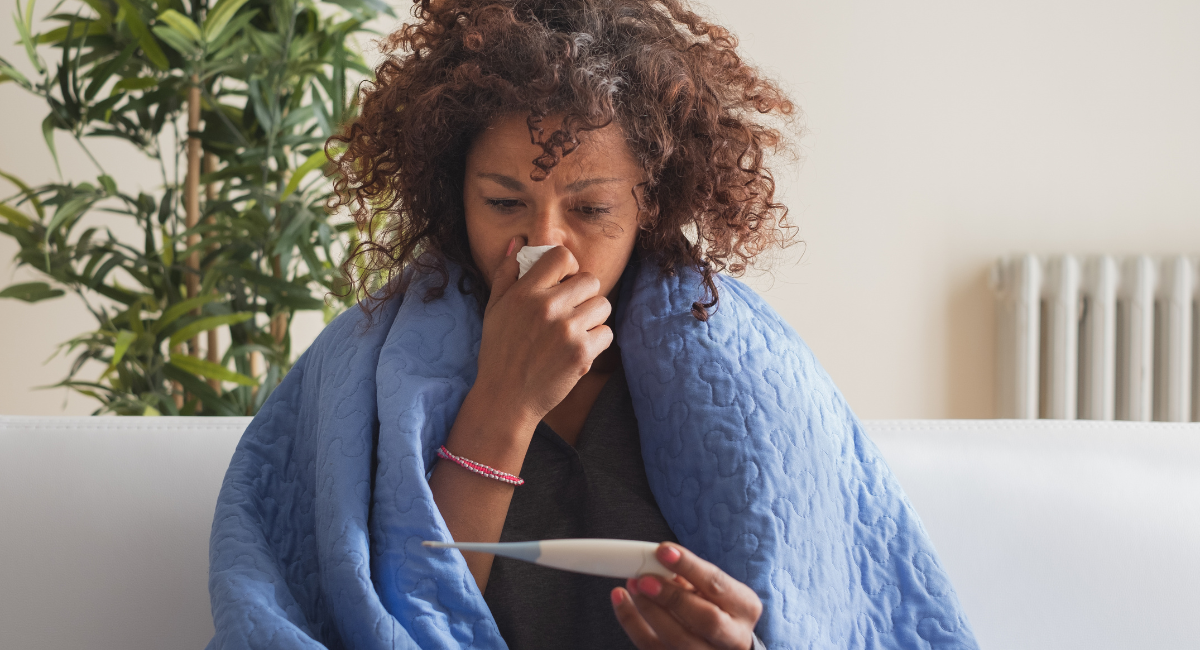
As temperatures drop and we spend more time indoors, cold and flu season arrives like an unwelcome house guest. Each year, millions of people face the discomfort and disruption of these common illnesses.
Whether you’re wondering about the difference between a cold vs. the flu, curious about the latest in treatments, or simply looking for ways to boost your immune system, Tryon Medical Partners internal medicine specialist Vanessa Ott shares some key information about how to face the sniffles with confidence.
When is the cold and flu season?
Typically, cold and flu season would start in the fall and run through the winter, with few cases in the spring and summer. However, the onset of the COVID-19 pandemic has shifted when rates of upper respiratory viruses are high. Cold and flu season now typically begins as early as late August and runs all the way through May. The COVID-19 virus never truly disappears, though cases are more frequent at certain times and in certain seasons, as we have seen this past summer.
“We are currently still seeing a lot of COVID-19 cases from the summer spike,” PA Ott shares. “We even had our first case of the flu in August. Around 20% to 30% of the patients I see daily are coming in with upper respiratory viruses.”
What’s the difference between a cold and the flu? Or other upper respiratory illnesses?
PA Ott emphasizes that all upper respiratory illnesses are distinct viruses, though they have quite similar symptoms. For instance, summer colds are commonly enterovirus and rhinovirus. Spring and early summer colds are often adenovirus, and winter often comes with respiratory syncytial virus (RSV) and parainfluenza. They all share many of the same symptoms, including:
- Cough
- Runny nose
- Sore throat
- Fever
- Diarrhea
“Although the symptoms are often similar, different strains have different symptoms,” PA Ott says. “For instance, fever is much more likely with the flu than it is with a cold. Common cold symptoms can differ greatly from patient to patient.”
Especially with COVID-19, the prevalence of gastrointestinal symptoms instead of more traditional upper respiratory symptoms can cause confusion and shock when people test positive for the virus.
“Patients come in with all different symptoms, and many of them would never guess they have COVID,” PA Ott shares. “In fact, sometimes they test on their first day of symptoms, test negative, and stop testing. Often, they’ll eventually test positive on the third or fourth day. So it’s important to know how different these symptoms might look.”
How can I prevent getting sick this cold and flu season?
In general, PA Ott recommends that you:
- Get enough sleep. Aim for 8 hours of sleep a night.
- Boost your immune system. Take Vitamin C and Vitamin D3 to proactively strengthen your immune system.
- Protect yourself from others. Especially during cold and flu season, keep your distance from people who are sick. If you’re sick, avoid going out in public.
- Be diligent with hand-washing. Wash your hands frequently and try not to touch your face, eyes, nose, or mouth.
- Keep your house clean. Clean and disinfect commonly used areas, like kitchen counters, toilets, doorknobs, and phones.
- Don’t miss your vaccination. If you’re older than 65, have a chronic condition like asthma, COPD or diabetes, or are immunocompromised, get vaccinated for all upper respiratory conditions. If you’re otherwise healthy, get the flu and COVID-19 vaccinations every year.
“Thanks to the COVID-19 pandemic, we’re now much more aware of how helpful masks can be in stopping the spread of viruses,” PA Ott says. “Use equipment like masks so you can protect yourself and those around you from illness.”
When is it time to see the doctor?
Most patients with a cold or the flu can recover at home without medical intervention. However, this depends on the patient. If you are immunocompromised or have chronic conditions and come down with a cold or the flu, it’s better to visit the doctor to make sure you can recover quickly and fully.
Flu treatments typically begin within two days of symptom onset, and COVID-19 treatments need to begin within five days of symptom onset, so if you’re resting and feeling worse, or can’t get out of bed, it’s time to see a doctor.
“It can be hard to differentiate between the illnesses to know what you have,” PA Ott says. “You can take an at-home COVID-19 test, flu test, or even a test that checks for both, to see what you’re dealing with.”
If you test at home and know what virus you’re battling, Tryon Medical Partners clinicians would be happy to see you virtually so you don’t have to leave the comfort of your couch or bed to get the treatments you need.
“But if you can’t test at home, it’s not a problem,” PA Ott emphasizes. “If you’re feeling really sick, don’t hesitate to come in! We want to make sure you can get well.”
If you have any questions about how to protect yourself, or think you or a loved one might need some cold and flu season support, use MedChat or call Tryon Medical Partners today.

